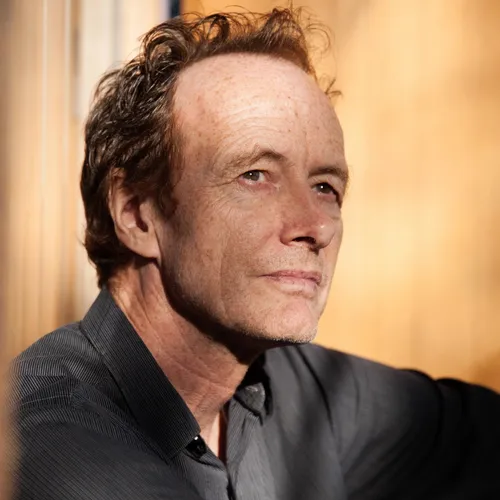
Beat Furrer received his first musical training on piano at the Music School there. After moving to Vienna in 1975, he studied conducting with Otmar Suitner and composition with Roman Haubenstock Ramati at the Hochschule für Musik und Darstellende Kunst. In 1985 he founded the Klangforum Wien, which he directed until 1992, and with which he is still associated as conductor. Commissioned by the Vienna State Opera, he composed his first opera Die Blinden in 1989. Narcisse was premiered in 1994 as part of the Festival “Steirischer herbst” at the Graz Opera. In 1996 he was composer-in-residence at the Lucerne Festival. His music theatre work “BEGEHREN” was premiered in Graz in 2001, the opera invocation in Zürich in 2003 and the sound theatre piece Fama in Donaueschingen in 2005. In autumn 1991 Furrer became a full professor of composition at the Hochschule für Musik und Darstellende Kunst in Graz. He has been guest professor in composition at the Hochschule für Musik und Darstellende Kunst in Frankfurt 2006–2009.
In 2004 he was awarded the Music Prize of the City of Vienna, and in 2005 became a member of the Academy of Arts in Berlin. He was awarded the Golden Lion at the Venice Biennale in 2006 for his work Fama, and in 2014 the Great Austrian State Prize. In 2010 his music theatre Wüstenbuch was premiered at the Theater Basel, in 2015 his opera La bianca notte / the bright night at the Hamburg State Opera.
Beat Furrer has been awarded the Ernst von Siemens Musikpreis 2018. In January 2019, his new opera Violetter Schnee (Violet Snow) was premiered at Berlin State Opera Unter den Linden.
NOTICE
(for piano and ensemble)
"Concerto for piano and ensemble" Beat Furrer is the extension and the culmination of his compositional study of the sounds of the piano, its phenomena, its resonances, its harmonic spectra, the use of pedals, previously explored in the works for solo piano like Phasma (2002) or DreiKlavierstücke (2004) and in Nuun for two pianos and ensemble (1995/1996). "My main goal was", says Beat Furrer, "to give the piano a resonance throughout the piece and maintain the plasticity of its sounds. These sounds are still the center of gravity of the piece while the orchestra plays the role of amplifier, giving an extended piano sound". Concerto for piano and ensemble sound spatialization using the piano as a compositional technique. The large ensemble is the echo chamber of the solo instrument, in which the different sounds and possibilities of articulation of the piano are amplified: from metal, shattering into crystal. Particular emphasis is given to the sounds and trembling tones of the low notes of the strings: the "non-tempered in the temperate" here is the starting point for the harmonic development. (...) Muted notes of the low keys of the solo piano acquire a resonance by the instruments of the orchestra and the sounds of Piccolo's second piano: they flow so to speak, from the solo instrument into the acoustic environmental space. Of these vibrations, Beat Furrer develops a rapid movement of sextuplets, which result in the complete device ever more dazzling cascades of piano solo. The early harmonic structures are transformed into rhythmic structures.
Le martellato (hammered) sets the sextuplets that turn more and more the whole expression of the event.
The result is a figure carried deeper into the suction of the motor movement. The increase corresponds to a dynamic expansion of the sound space, up to the high notes of the piano, accordion and trumpet, combined with a sound transformation. "The process leading to more and more metallic sound, high pitched, like a gong. It is interrupted by two lines gradually ascending, tones and resonances leading to the most acute that can be comparable to the sound of a woodblock. Thus began a process of modulation to the crystalline sounds. Glass bottles begin a descending line, the piano is also used. During these repeated periods in the high note regions, the martellato indicates a turning point to another sound, isolated, brutal." (...)
Marie-Louise Maintz
(translated from German by Aude Grandveau)
Nero su nero (black on black) speaks of gradations of darkness, of the nuancing of light, the application of colour without colour, the stratification of pigments, of intensification. A multiple fanned-out overlapping of voices, whose particles rest on quite elementary forms of movement is the colour material. In the composition two great sections composed of heterogeneous elements frame a slow central part which emerges as a great inexorable development leading to a bright, loud, frenetic blaze. A continuous intensification is pared from almost imperceptible alterations, which takes the action to a tremendous dramatic high point.
The structural model, says Beat Furrer, consists of a principle of assembly developed to the highest complexity and yet simplicity: “It is about the creation of melody from the interpolation of heterogeneous elements. In the first part these are two layers; a great colourfulness is created of these two structures interpolated into each other. In the central part there is just one layer. The very long central section is concerned with achieving a continuous alteration of colour instrumentally as well as harmonically – from darkness to light. Within this development there is nevertheless still a structural polyphony of various kinds of movement in the strings, at different speeds with the ascending and descending lines. The sequencing models are based on chromatic and other intervallic combinations which pass by superimposed in the tonal landscape, so that a kind of unending movement of wandering overtones is produced. In the last part the descending chromaticism in the strings is continued, as overtones of a chromatic line.”
Marie Luise Maintz